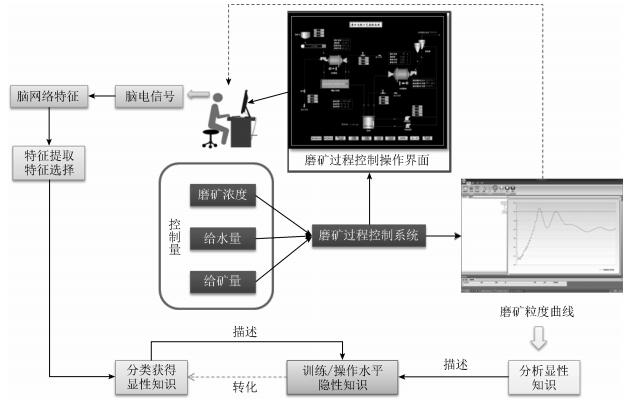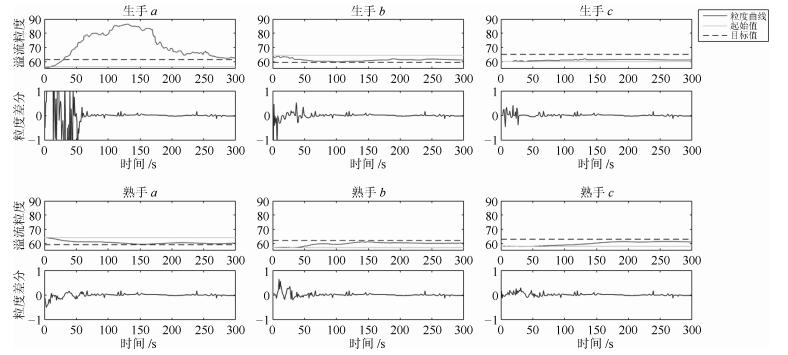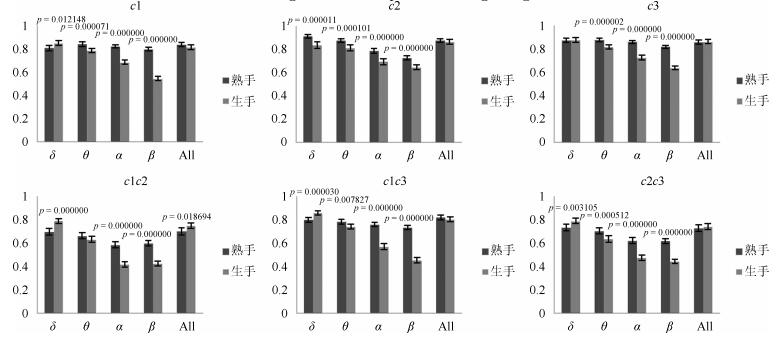Knowledge Automation-oriented Brain Cognitive Feature and Control Effect Analysis of Operator in Mineral Grinding Process
-
摘要: 面向知识型工作自动化,研究了流程工业生产过程中操作人员的脑认知特征与操作控制水平之间的关键,建立了一种基于操作员脑网络特征的操作熟练程度隐性知识的显性化模型.采用关注信号瞬时相位、基于希尔伯特变换的相位锁方法,构建了脑功能网络(Functional brain network,FBN).基于磨矿系统操作员脑功能网络的图论参数与社区连接强度,建立了特征空间,采用支持向量机与神经网络进行特征分类.结果表明,在高频区,熟练操作员(熟手)的脑功能网络连接强度明显高于不熟练操作员(生手):在低频部分则生手的脑功能网络连接强度略高,其特征分类准确率为87.24%.磨矿系统操作过程中形成的溢流粒度(Grinding particle size,GPS)曲线可以初略地反映操作人员的熟练程度,本文在深入分析了其溢流粒度曲线与操作员脑网络特征的基础上,发现相对于溢流粒度曲线操作员的脑网络特征可以更全面地描述操作控制水平(特别在操作开始时间段),采用脑网络特征识别操作控制水平在时间上超前于溢流粒度曲线识别方法.本研究对于将知识工作者的认知特征引入到流程工业控制中,具有一定的借鉴意义.Abstract: Towards knowledge work automation, the paper studies the key correlation between brain cognitive feature and operation level of operators in the process industrial production, and models the explication of tacit knowledge based on the functional brain network (FBN) feature of operators. Using phase locking value method based on the Hilbert transform focusing on instantaneous phase we construct FBN, and then apply parameters of graphic theory and link strength of community analysis of FBN of operators to the mineral grinding processing automated system, so as to obtain the feature space. The result of classification using SVM and ANN classifier suggests that the connection strength of FBNs of old hands is significantly higher than that of new learners in high frequency, while that of new learners is slightly higher in low frequency, and the accuracy of classification is 87.24%. The grinding particle size (GPS) represents the operation level initially and roughly. According to the deep analysis of GPS and FBN features, the paper suggests that the FBN features can describe the operation level more comprehensively (especially in the initial stage of operation) than GPS. The operation level detection based on FBN features is more look-ahead than based on GPS curves in time. The research provides a reference for introducing the cognitive features of knowledge worker into the process industry.
-
-
表 1 主成分分析得到的各个成分的相关参数与可分性判据
Table 1 The properties and the sort separability criterion of the PCA components
成分 贡献(方差) 相关性 t检验显著性 AUC SVM交叉验证平均准确率 成分1 28.3801 −0.6670** 1.005E−50 0.8820 0.7865 成分2 20.0231 0.1570** 0.0021 0.4036 0.6302 成分3 10.7873 -0.0844 0.0987 0.5406 0.5182 成分4 10.3419 0.0729 0.1540 0.4637 0.5234 成分5 4.9439 -0.0538 0.2926 0.5214 0.4870 成分6 3.3562 −0.2060** 4.881E−05 0.6108 0.5990 成分7 2.5598 −0.1020* 0.0467 0.5497 0.5443 成分8 2.3139 0.0863 0.0915 0.4414 0.5391 表 2 不同分类方式的性能评价
Table 2 The performance assessment of different classifiers and feature vectors
分类方式/评价 准确率(%) 精确度(%) 召回率(%) F测度(%) AUC(%) SVM分类器成分(1, 2, 6, 7) 84.90 ± 6.77 85.57 ± 8.41 84.90 ± 10.13 84.82 ± 7.08 92.74 ± 5.64 SVM分类器成分(1, 2, 6, 7, 8, 4, 3, 5) 85.42 ± 4.28 86.19 ± 5.00 84.90 ± 4.97 85.16 ± 4.97 92.45 ± 3.85 带高斯核函数的SVM分类器成分(1, 2, 6, 7) 86.72 ± 5.51 85.76 ± 7.84 89.06 ± 8.48 87.01 ± 5.40 93.42 ± 5.63 带高斯核函数的SVM分类器成分(1, 2, 6, 7, 8, 4, 3, 5) 87.24 ± 6.31 83.01 ± 7.01 94.27 ± 7.28 88.11 ± 5.94 93.82 ± 5.24 神经网络分类器成分(1, 2, 6, 7) 82.03 ± 6.81 81.38 ± 11.33 85.94 ± 8.05 82.88 ± 5.73 82.03 ± 6.81 神经网络分类器成分(1, 2, 6, 7, 8, 4, 3, 5) 86.46 ± 7.34 87.10 ± 9.21 86.46 ± 8.77 86.47 ± 7.27 86.46 ± 7.34 -
[1] 王飞跃.软件定义的系统与知识自动化:从牛顿到默顿的平行升华.自动化学报, 2015, 41(1):1-8 http://www.aas.net.cn/CN/abstract/abstract18578.shtmlWang Fei-Yue. Software-defined systems and knowledge automation:a parallel paradigm shift from Newton to Merton. Acta Automatica Sinica, 2015, 41(1):1-8 http://www.aas.net.cn/CN/abstract/abstract18578.shtml [2] 张方风, 郑志刚.复杂脑网络研究:现状与挑战.上海理工大学学报, 2012, 34(2):138-153 http://kns.cnki.net/KCMS/detail/detail.aspx?filename=hdgy201202003&dbname=CJFD&dbcode=CJFQZhang Fang-Feng, Zheng Zhi-Gang. Complex brain networks:progresses and challenges. Journal of University of Shanghai for Science and Technology, 2012, 34(2):138-153 http://kns.cnki.net/KCMS/detail/detail.aspx?filename=hdgy201202003&dbname=CJFD&dbcode=CJFQ [3] Stam C J, de Haan W, Daffertshofer A, Jones B F, Manshanden I, van Cappellen van Walsum A M, Montez T, Verbunt J P A, de Munck J C, van Dijk B W, Berendse H W, Scheltens P. Graph theoretical analysis of magnetoencephalographic functional connectivity in Alzheimer's disease. Brain, 2008, 132(1):213-224 doi: 10.1093/brain/awn262 [4] 王行愚, 金晶, 张宇, 王蓓.脑控:基于脑——机接口的人机融合控制.自动化学报, 2013, 39(3):208-211 http://www.aas.net.cn/CN/abstract/abstract17800.shtmlWang Xing-Yu, Jin Jing, Zhang Yu, Wang Bei. Brain Control:human-computer integration control based on brain-computer interface. Acta Automatica Sinica, 2013, 39(3):208-211 http://www.aas.net.cn/CN/abstract/abstract17800.shtml [5] Lachaux J P, Rodriguez E, Martinerie J, Varela F J. Measuring phase synchrony in brain signals. Human Brain Mapping, 1999, 8(4):194-208 doi: 10.1002/(ISSN)1097-0193 [6] Sauseng P, Klimesch W. What does phase information of oscillatory brain activity tell us about cognitive processes? Neuroscience and Biobehavioral Reviews, 2008, 32(5):1001-1013 doi: 10.1016/j.neubiorev.2008.03.014 [7] Celka P. Statistical analysis of the phase-locking value. IEEE Signal Processing Letters, 2007, 14(9):577-580 doi: 10.1109/LSP.2007.896142 [8] Sporns O. Structure and function of complex brain networks. Dialogues in Clinical Neuroscience, 2013, 15(3):247-262 http://www.ncbi.nlm.nih.gov/pmc/articles/PMC3811098/figure/DialoguesClinNeurosci-15-247-g007/ [9] Rubinov M, Sporns O. Complex network measures of brain connectivity:uses and interpretations. NeuroImage, 2010, 52(3):1059-1069 doi: 10.1016/j.neuroimage.2009.10.003 [10] Ahmadlou M, Adeli H. Functional community analysis of brain:a new approach for EEG-based investigation of the brain pathology. NeuroImage, 2011, 58(2):401-408 doi: 10.1016/j.neuroimage.2011.04.070 [11] Lu S W, Zhou P, Chai T Y, Dai W. Modeling and simulation of whole ball mill grinding plant for integrated control. IEEE Transactions on Automation Science and Engineering, 2014, 11(4):1004-1019 doi: 10.1109/TASE.2013.2296309 [12] 卢绍文.磨矿破裂过程的蒙特卡洛仿真方法研究.东北大学学报(自然科学版), 2014, 35(6):770-773, 808 http://d.wanfangdata.com.cn/Periodical/dbdxxb201406003Lu Shao-Wen. Research on Monte Carlo simulation of grinding breakage process. Journal of Northeastern University (Natural Science), 2014, 35(6):770-773, 808 http://d.wanfangdata.com.cn/Periodical/dbdxxb201406003 [13] 卢绍文, 余策.磨矿粒度动态过程的一种快速Monte Carlo仿真方法.自动化学报, 2014, 40(9):1903-1911 http://www.aas.net.cn/CN/abstract/abstract18460.shtmlLu Shao-Wen, Yu Ce. A fast Monte Carlo algorithm for dynamic simulation of particle size distribution of grinding processes. Acta Automatica Sinica, 2014, 40(9):1903-1911 http://www.aas.net.cn/CN/abstract/abstract18460.shtml [14] Honey C J, Kötter R, Breakspear M, Sporns O. Network structure of cerebral cortex shapes functional connectivity on multiple time scales. Proceedings of the National Academy of Sciences of the United States of America, 2007, 104(24):10240-10245 doi: 10.1073/pnas.0701519104 [15] Stam C J, Van Dijk B W. Synchronization likelihood:an unbiased measure of generalized synchronization in multivariate data sets. Physica D:Nonlinear Phenomena, 2002, 163(3-4):236-251 doi: 10.1016/S0167-2789(01)00386-4 [16] Pereda E, Quiroga R Q, Bhattacharya J. Nonlinear multivariate analysis of neurophysiological signals. Progress in Neurobiology, 2005, 77(1-2):1-37 doi: 10.1016/j.pneurobio.2005.10.003 [17] Miller E K, Cohen J D. An integrative theory of prefrontal cortex function. Annual Review of Neuroscience, 2001, 24:167-202 doi: 10.1146/annurev.neuro.24.1.167 [18] Theodoridis S, Theodoridis K. Pattern Recognition (4th Edition). Burlington:Academic Press, 2008. 323-350 [19] Webb A R, Copsey K D. Statistical Pattern Recognition (3rd Edition). Chichester, UK:John Wiley & Sons, 2011. 435-455 [20] 孙会文, 伏云发, 熊馨, 杨俊, 刘传伟, 余正涛.基于HHT运动想象脑电模式识别研究.自动化学报, 2015, 41(9):1686-1692 http://www.aas.net.cn/CN/abstract/abstract18742.shtmlSun Hui-Wen, Fu Yun-Fa, Xiong Xin, Yang Jun, Liu Chuan-Wei, Yu Zheng-Tao. Identification of EEG induced by motor imagery based on Hilbert-Huang transform. Acta Automatica Sinica, 2015, 41(9):1686-1692 http://www.aas.net.cn/CN/abstract/abstract18742.shtml [21] Basheer I A, Hajmeer M. Artificial neural networks:fundamentals, computing, design, and application. Journal of Microbiological Methods, 2000, 43(1):3-31 doi: 10.1016/S0167-7012(00)00201-3 [22] 杨淑莹.模式识别与智能计算:Matlab技术实现.第2版.北京:电子工业出版社, 2011. 134-140Yang Shu-Ying. Pattern Recognition and Intelligent Computing:Technical implement of Matlab (2nd Edition). Beijing:Publishing House of Electronics Industry Press, 2011. 134-140 -






 下载:
下载:








